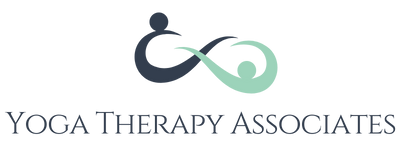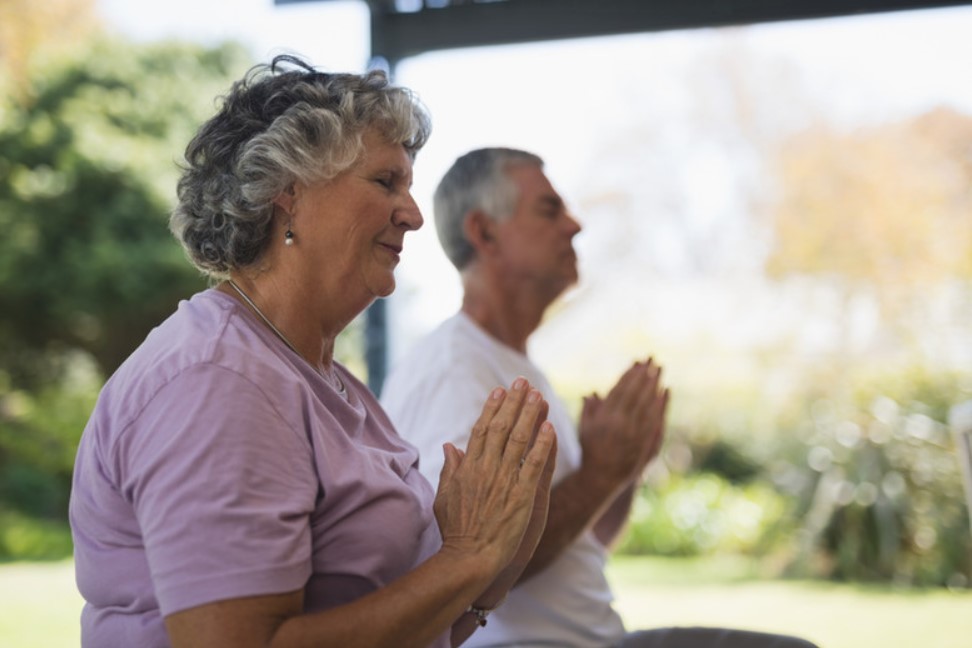By Sara Merrick-Albano, E-RYT, C-IAYT and Christine Saari, MA, E-RYT, C-IAYT
Are you a healthcare provider dealing with patients who suffer from chronic low back pain and are seeking non-surgical alternatives to alleviate their daily struggles? Have you come across cases where patients have faced challenges in following their physical therapy program or experienced mental distress due to their back pain, significantly impacting their quality of life?
As a physician, you’re likely aware that effective pain management is a significant priority for patients suffering from disc herniation and back pain. You may or may not be familiar with the growing recognition of yoga therapy as a promising and effective option to manage symptoms of herniated discs, including pain1.
Disc herniation, commonly known as slipped disc, bulging disc, or ruptured disc, is one of the most prevalent causes of back pain2. The intervertebral discs are fibrocartilaginous structures located between the vertebrae of the spinal column that act as shock absorbers and provide flexibility to the spine. When the outer layer of these discs weakens, it can result in the protrusion of the soft, inner layer, which can put pressure on the adjacent spinal nerves, leading to acute discomfort and pain.
Supported by research-based evidence, medical professionals are increasingly utilizing yoga therapy as a complementary treatment option to support patients in alleviating pain associated with herniated discs.
In this article, we will explore why yoga therapy differs from other treatment options such as physical therapy or generalized yoga classes, how yoga therapy helps manage symptoms of disc herniation, and when to consider referring your patients for yoga therapy as part of an integrative treatment plan.
Why Yoga Therapy Excels in Managing Symptoms of Herniated Discs
You might be wondering: why not just send patients suffering from disc herniation to a physical therapist or to generalized yoga classes? Why refer them to a yoga therapist specifically?
When it comes to addressing a patient’s concerns and symptoms related to herniated discs, it is important to consider complementary treatment options that offer tailored approaches beyond the scope of traditional physical therapy and generalized yoga classes.
Let’s explore the distinct benefits of integrating yoga therapy into the treatment of disc herniation pain.
Yoga Therapy as an Alternative to Physical Therapy for Chronic Pain Remediation
Yoga therapy offers a compelling approach for managing herniated disc pain when compared to traditional physical therapy. Its effectiveness lies in its ability to address not only the physical aspects of pain, but also the neurological aspects of the chronic pain experience. Additionally, a yoga therapy approach emphasizes the recruitment of the parasympathetic nervous system response to facilitate muscular change.
Chronic pain, particularly associated with herniated discs, extends beyond mere physical symptoms. It encompasses the interplay of psychological and emotional factors, creating a complex experience for individuals.
Yoga therapy acknowledges and addresses this multifaceted nature of chronic pain by adopting a holistic approach that integrates the brain-body connection. Directed awareness is a powerful technique used by yoga therapists to localize pain and disrupt learned pain responses. By focusing individuals’ attention on specific areas of discomfort, directed awareness can reshape neural pathways in the brain, influencing the way pain is interpreted and signaled. This process gradually reduces pain perception and enhances the brain’s ability to manage and cope with chronic pain, offering lasting relief through the rewiring of pain-processing circuits.
One key differentiating factor of yoga therapy for chronic pain is its emphasis on inducing a parasympathetic nervous system response during directed awareness activities. By incorporating deep, slow breathing techniques, restorative postures, and mindfulness practices, yoga therapy promotes relaxation and counters the stress response commonly associated with chronic pain. This activation of the parasympathetic nervous system creates an optimal environment for healing, allowing the body to release tension, reduce inflammation, and promote overall well-being.
In contrast, while physical therapy primarily concentrates on physical rehabilitation, strengthening, and stretching, it may not adequately address the complex neurobiological and psychological aspects of chronic pain.
Yoga therapy’s comprehensive approach, on the other hand, fosters a profound brain-body connection, creating the potential for significant shifts in the experience of pain while facilitating long-term muscular changes. Its holistic nature makes it an ideal choice for individuals seeking a comprehensive approach that recognizes and addresses the multidimensional nature of herniated disc pain.
Yoga Therapy as a Safer and More Effective Alternative to General Yoga Classes
Considering yoga as a beneficial option for chronic pain management, one might question the suitability of sending patients to a general yoga class.
It is crucial to recognize that yoga classes may not provide a safe environment for individuals with herniated discs, mainly due to the lack of specialized training among most yoga teachers in pathology and the contraindications specific to herniated discs.
Unlike general yoga classes, yoga therapy provides a personalized and individualized experience, focusing on the unique needs of individuals living with herniated disc pain. The individualized approach of yoga therapy is especially important because different bodies need different things.
Yoga therapists work with patients one-on-one, tailoring treatment and practice plans to the individual’s unique body and symptoms. A yoga class, on the other hand, is often designed for a group of people with varying levels of experience and abilities, and may not address the specific needs of someone with herniated disc pain. In our clinical experience, yoga therapy is more effective than general yoga classes for helping to mitigate pain and symptoms in individuals.
Yoga Therapy is a Wiser Investment Than Generalized Yoga Classes
Investing in yoga therapy, despite its higher cost compared to generalized yoga classes, is a wise choice for individuals suffering from low back pain. Yoga therapy offers targeted and personalized treatment, resulting in faster relief that clients are desperate for, while significantly reducing the risk of acute pain or potential injury that could arise from participating in a generalized yoga class without proper guidance and modifications specific to their condition. Opting for 4-6 sessions with a yoga therapist not only proves cost-effective, but also ensures a safer and more tailored approach, maximizing the chances of finding relief and minimizing the risk of exacerbating their condition.
Now, let us delve into these advantages and explore how yoga therapy functions as a valuable tool in effectively managing symptoms associated with herniated discs.
How Does Yoga Therapy Help Manage Symptoms of Herniated Discs?
1. Yoga Therapy Helps Build Strength and Flexibility
We have established that through a combination of tailored postures, intentional breathwork, and directed awareness, yoga therapy fosters an environment that supports chronic pain relief through neuroplasticity and the rewiring of physiological patterns.
Additionally, yoga therapy can mitigate symptoms of muscle weakness and stiffness associated with herniated discs. In order to help manage these symptoms, yoga therapists work with clients to increase core strength of the deeper abdominal muscles, providing support for the spine through axial extension, and strengthening weak areas of the body.
Another way yoga therapy may help mitigate symptoms of disc herniation is by stretching tight areas of the body. One study published in January 2023 determined that “stretch and strength-based yoga exercise could be a promising treatment option for neuropathic pain” due to lumbar disc herniation. Low back pain and disability decreased while function increased in the yoga group compared with the control group. Pain was measured using the modified Schober and passive knee extension test.3 This further supports the use of yoga therapy referrals to promote pain mitigation in disc herniation patients.
But does this approach work?
A 2019 study conducted by the Boston Medical Center asserts that yoga “designed for chronic low back pain patients was as effective as physical therapy.”4 Another study reviewed thirty articles on 27 individual studies and concluded that “yoga revealed robust short-term and long-term effects for pain, disability, physical function, and mental health, when compared with non-exercise controls.”5
Based on these findings, as well as on the growing body of clinical data, yoga therapy presents physicians with a viable referral option for patients suffering from pain due to disc herniation.
2. Yoga Practices Activate the Parasympathetic Nervous System
Activating the parasympathetic nervous system is crucial in managing low back pain effectively, and yoga therapy offers practices that achieve this goal. The parasympathetic nervous system promotes relaxation and lowers stress levels. Yoga therapy utilizes mindfulness-based techniques and conscious breathing exercises to shift the body from the sympathetic “fight-or-flight” response to a parasympathetic state of calm and relaxation.
Stress, both physical and psychological, significantly impacts low back pain levels. Stress hormones like cortisol can worsen inflammation, muscle tension, and pain sensitivity, exacerbating low back pain symptoms. Yoga therapy addresses this by activating the parasympathetic nervous system. Mindfulness-based techniques cultivate present-moment awareness, breaking the cycle of stress and chronic pain. Conscious breathing exercises stimulate the vagus nerve, promoting relaxation, reducing muscle tension, and alleviating low back pain.
By targeting the parasympathetic nervous system, yoga therapy empowers individuals to effectively manage their low back pain. By reducing stress, promoting relaxation, and leveraging the body’s natural healing mechanisms, yoga therapy offers a holistic approach that recognizes the brain-body connection and provides tools for individuals to actively participate in their pain management. Through the integration of mindfulness and conscious breathing, yoga therapy enables individuals to create an optimal environment for healing and improve their overall well-being.
3. Yoga Therapy Enhances Interoception and Proprioception for Physiological Reprogramming
Yoga therapy offers invaluable brain-body awareness practices, including interoception and proprioception, that contribute to mitigating symptoms of disc herniation. Interoception refers to the ability to perceive and interpret internal bodily sensations, such as heartbeat, breathing, and pain. Proprioception, on the other hand, relates to the sense of body position and movement in space.
In managing low back pain, interoception helps individuals attune to their body’s signals, allowing them to identify pain triggers, discomfort, and changes in their condition. Proprioception, on the other hand, supports the development of proper body mechanics and postural alignment, reducing strain and promoting optimal movement patterns, which can alleviate low back pain and support long-term management. Developing both interoception and proprioception skills is crucial for clients to effectively manage their own low back pain.
By working closely with clients, yoga therapists facilitate the development of these skills, enabling individuals to sensitize themselves to their bodily signals and observe early warning signs of discomfort.
Yoga Therapist as Educator in Sensory Skill-Building
A yoga therapist is uniquely positioned to impart these skills, as yoga provides a rich array of techniques specifically designed to cultivate and enhance these sensory abilities. By harnessing the practices offered by yoga, clients can gain the necessary tools to strengthen their awareness of internal bodily sensations and improve their body’s position and movement awareness, empowering them to take an active role in managing their low back pain.
Through the use of a prescribed home practice plan, yoga therapists support clients to reprogram their physiological patterning. As they become more attuned to their body’s signals, individuals can proactively modify their movement patterns and postural habits, fostering healthier alignment and reducing the strain on the affected areas. This heightened awareness allows individuals to proactively address patterns that contribute to their disc herniation symptoms, fostering improved movement mechanics, pain reduction, and increased functional mobility.
This approach of utilizing awareness through interoceptive and proprioceptive sensing plays a pivotal role in facilitating long-term recovery that extends beyond the boundaries of traditional rehabilitation methods.
Empowered with self-awareness and the capacity for self-regulation, clients assume an active role in their healing process, making informed choices that directly impact their daily quality of life. Yoga therapy offers a holistic approach that empowers clients to develop a more harmonious relationship with their body, ultimately supporting their journey towards optimal health and well-being.
4. Yoga Therapy Cultivates Directed Awareness to Reduce Chronic Pain
Yoga therapy embraces a unique approach to alleviate chronic pain by cultivating directed awareness. This therapeutic modality recognizes that chronic pain extends beyond the physical realm and encompasses psychological and emotional factors. By integrating the brain-body connection, yoga therapy targets chronic pain from a holistic perspective, acknowledging the complex interplay between various aspects of an individual’s experience.
Yoga therapists employ directed awareness techniques to localize pain and disrupt learned pain responses, thereby influencing the way the brain signals pain. Through focused attention and mindfulness, individuals develop a deeper understanding of their pain sensations and their relationship with them. This heightened awareness allows for a more nuanced exploration of pain triggers, patterns, and responses, leading to insights that can facilitate pain reduction and management.
The cultivation of directed awareness in yoga therapy empowers individuals to navigate and transform their experience of chronic pain. By developing a conscious and compassionate relationship with their pain, clients can gain a sense of agency and control. This approach not only provides immediate relief but also equips individuals with valuable skills for long-term pain management, enhancing their overall well-being and quality of life.
Choose Yoga Therapy as an Integrative Treatment for Herniated Discs
The American College of Physicians specifically recommends yoga as one of the conservative treatment options for acute or subacute low back pain, advising that: “For patients with chronic low back pain, ACP recommends that physicians and patients initially select non-drug therapy with exercise, multidisciplinary rehabilitation, acupuncture, mindfulness-based stress reduction, tai chi, yoga,”6 and more.
As a medical professional, you can confidently refer patients suffering from herniated disc pain to a yoga therapist as part of a first line of treatment.
Yoga therapy is uniquely situated as an evidence-based pre-surgical integrative health care option for patients suffering from herniated disc pain. One-on-one yoga therapy sessions are essential to customize the postures that will develop the strength and flexibility needed to manage back pain and stiffness that come with disc herniation. Additionally, a yoga therapist can work with the individual to prescribe specific breathing techniques and awareness practices to facilitate parasympathetic nervous system response, enhance interoception and proprioception, and reduce chronic pain.
The benefits of yoga therapy as a powerful tool in managing herniated disc symptoms are certainly worth exploring. Yoga Therapy Associates aims to implement yoga therapy programs as complementary therapy within organizations and institutions, to provide integrative health education services, and to connect individuals suffering from health conditions with qualified yoga therapists. Here are a few resources you can use to explore prescribing yoga therapy as a complementary medicine for your patients:
1) Learn more about our experience using yoga therapy to help manage symptoms for individuals with chronic health conditions.
2) Request a meeting with a representative of Yoga Therapy Associates to discuss how yoga therapy might be able to support your patients.
3) Refer a patient to Yoga Therapy Associates for complementary healthcare. Referred patients receive a response within 24 hours and can expect to be seen within two weeks.
Yoga Therapy Associates currently accepts patients referred by their physician for integrative care supporting healing, reducing suffering from chronic conditions, and slowing degenerative disease progression.
Yoga Therapy Associates offers yoga therapy at four locations in Connecticut and via telehealth.
References
- Yildirim, P., & Gultekin, A. (2022). The effect of a stretch and strength-based yoga exercise program on patients with neuropathic pain due to lumbar disc herniation. Spine, Publish Ahead of Print. https://doi.org/10.1097/brs.0000000000004316
- “Herniated Disk in the Lower Back.” OrthoInfo – American Academy of Orthopaedic Surgeons, n.d., https://orthoinfo.aaos.org/en/diseases–conditions/herniated-disk-in-the-lower-back/
- Yildirim, P., & Gultekin, A. (2022). The effect of a stretch and strength-based yoga exercise program on patients with neuropathic pain due to lumbar disc herniation. Spine, Publish Ahead of Print. https://doi.org/10.1097/brs.0000000000004316
- Bard, G. (2023, May 22). Yoga as effective as physical therapy for chronic low back pain. Spinal News International. Retrieved from https://spinalnewsinternational.com/yoga-as-effective-as-physical-therapy-for-chronic-low-back-pain/
- Anheyer, D., Haller, H., Lauche, R., Dobos, G., & Cramer, H. (2021). Yoga for treating low back pain: A systematic review and meta-analysis. Pain, 163(4). https://doi.org/10.1097/j.pain.0000000000002416
- American College of Physicians issues guideline for treating nonradicular low back pain. ACP. (2017, February 14). Retrieved October 25, 2022, from https://www.acponline.org/acp-newsroom/american-college-of-physicians-issues-guideline-for-treating-nonradicular-low-back-pain




